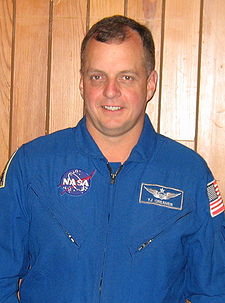Timothy Creamer
| Timothy John „T.J.“ Creamer | |
|---|---|
 | |
| Astronaut NASA | |
| Státní příslušnost | USA |
| Datum narození | 15. listopadu 1959 (63 let) |
| Místo narození | Fort Huachuca, Arizona, USA |
| Předchozí zaměstnání | Letec Armády USA |
| Hodnost | Podplukovník (2006) |
| Čas ve vesmíru | 163 dní, 5 hodin a 33 minut |
| Kosmonaut od | 4. června 1998 |
| Mise | Expedice 22/23 (Sojuz TMA-17/ISS) |
| Znaky misí | |
| Kosmonaut do | dosud aktivní |
| Některá data mohou pocházet z datové položky. | |
Timothy John Creamer (* 15. listopadu 1959 v Fort Huachuca, ve státě Arizona, USA) byl původně letec Armády USA, od června 1998 je americkým astronautem, členem oddílu astronautů NASA. Jako člen Expedice 22 a 23 na Mezinárodní vesmírné stanici (ISS) odstartoval 20. prosince 2009 do kosmu na palubě Sojuzu TMA-17.
Život
Voják
Timothy Creamer se narodil ve Fort Huachuca v Arizoně. Dětství prožil ve městě Upper Marlboro v Marylandu, roku 1978 ukončil střední školu v blízkém Forestville. Roku 1982 získal bakalářský titul z chemie na Loyola College v Baltimore. Poté sloužil v armádě. Roku 1992 získal magisterský titul z fyziky na Massachusettském technologickém institutu. Sloužil v Kosmickém velitelství armády USA (Army Space Command) v Houstonu. Od roku 1995 byl přeložen do Johnsonova vesmírného střediska stále v Houstonu, zde byl vedoucím skupiny testující vybavení Shuttlů před startem.[1]
Astronaut
Neúspěšně se přihlásil do 15. a 16. náboru astronautů NASA v letech 1995 a 1996. Úspěch slavil až napotřetí, v 17. náboru probíhajícím v letech 1997 – 1998. Astronautem se stal 4. června 1998. Absolvoval všeobecnou kosmickou přípravu a získal kvalifikaci letový specialista.[1]
Po skončení základního výcviku nadále pracoval v houstonském středisku NASA. Do posádky byl poprvé zařazen v únoru 2007, kdy se stal náhradníkem Timothyho Kopry, který měl odstartovat na ISS v lednu 2009 při letu STS-127. Let STS-127 byl nakonec odložen na červenec 2009.[1]
V září 2008 bylo oficiálně potvrzeno jmenování Creamera do Expedice 22 se startem na lodi Sojuz TMA-17.[1] Ke stanici odstartoval s kolegy Olegem Kotovem a Sóiči Nogučim 20. prosince 2009.[2]
Je rozvedený s Margaret E. Hammerovou, se kterou má dva syny.
Reference
- ↑ a b c d IVANOV, Ivan, a kol. Космическая энциклопедия ASTROnote [online]. Moskva: rev. 2008-12-12 [cit. 2009-09-14]. Kapitola Timothy John «TJ» Creamer. Dostupné online. (rusky)
- ↑ HOLUB, Aleš. MEK. Malá encyklopedie kosmonautiky [online]. Rev. 2009-12-20 [cit. 2009-12-21]. Kapitola Sojuz TMA-17. Dostupné online.
Externí odkazy
 Obrázky, zvuky či videa k tématu Timothy Creamer na Wikimedia Commons
Obrázky, zvuky či videa k tématu Timothy Creamer na Wikimedia Commons - Biographical data. Timothy John „T.J.“ Creamer [online]. NASA, rev. 2009-01 [cit. 2009-08-14]. Dostupné v archivu pořízeném dne 2009-07-23. (anglicky) – Oficiální biografie NASA
- Životopis na stránkách Spacefacts.de
Média použitá na této stránce
The 22nd Expedition to the International Space Station is dedicated to the final stages of assembly and the transition to full utilization as an orbiting laboratory. The sun, providing power and life support to the space station, shines through one of the solar arrays as the ISS orbits above Earth. The oceans and atmosphere, providing life support to Earth, are shown in all their beauty. The moon hovers in the distance as the goal of the next era of exploration. The six stars illustrate the increased capability of the crew complement. In the border are the national flags of the crew members as well as their surnames in their native languages. Expedition XXII continues the effort to acquire the knowledge necessary to extend the reach of exploration from Earth, to the moon and beyond.
The focal point of the Expedition XXIII emblem illustrates the beautiful planet Earth in the black expanse of space. The International Space Station (ISS) is shown traveling in its orbit around Earth. The ISS orbital path flies through the XXIII to show that this increment is building upon the missions that have gone on before and laying the groundwork for future missions. This illustrates the work being performed aboard the orbiting complex that will lead the way to eventual missions to the moon, Mars and beyond. The mission designation uses Roman numerals to illustrate the home nations of the crew, which are also represented by their national flags. The two stars represent the two teams that make up this expedition crew.
Autor: Tohma (talk), Licence: CC BY-SA 4.0
Timothy John Creamer, visit at the CJD Christophorusschule Königswinter


